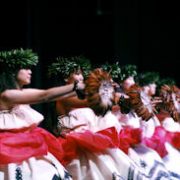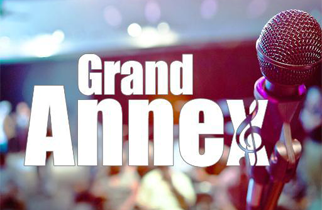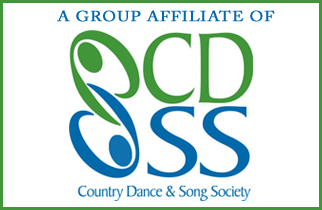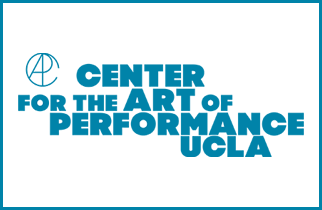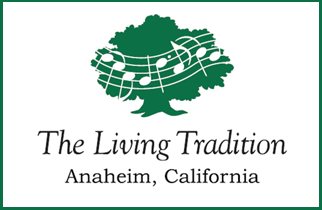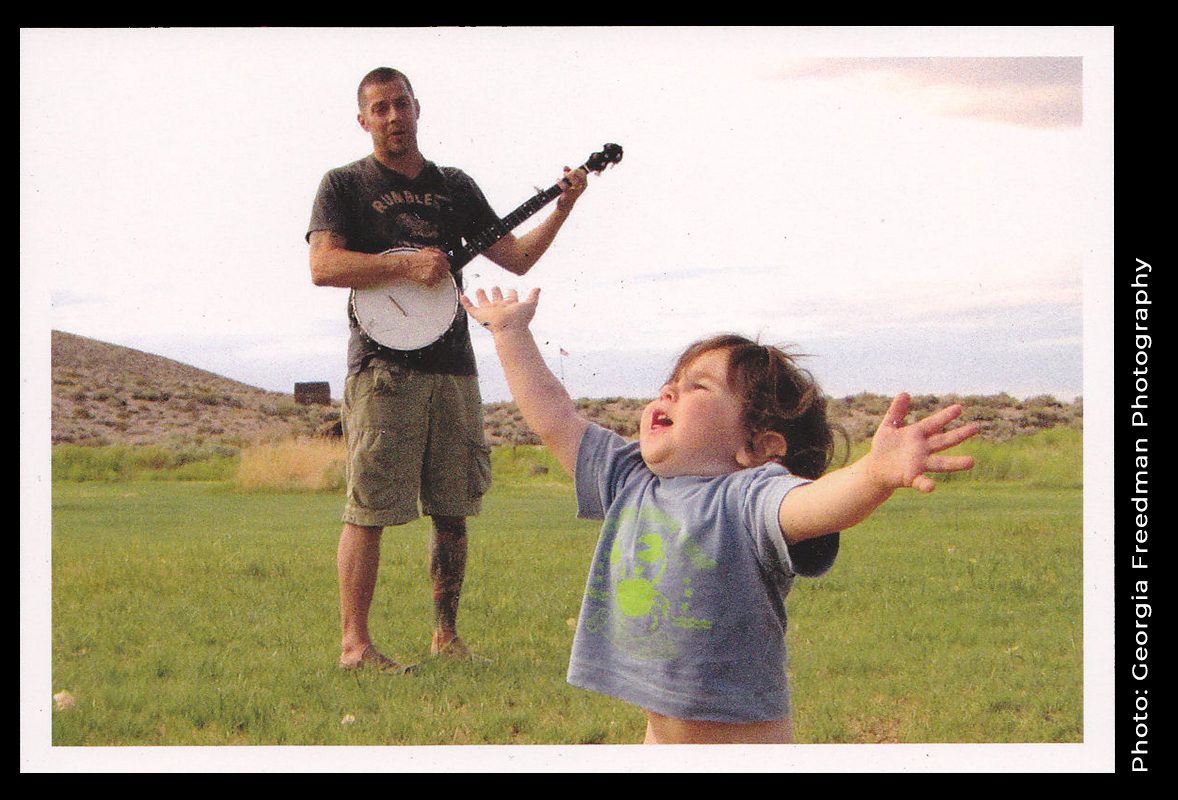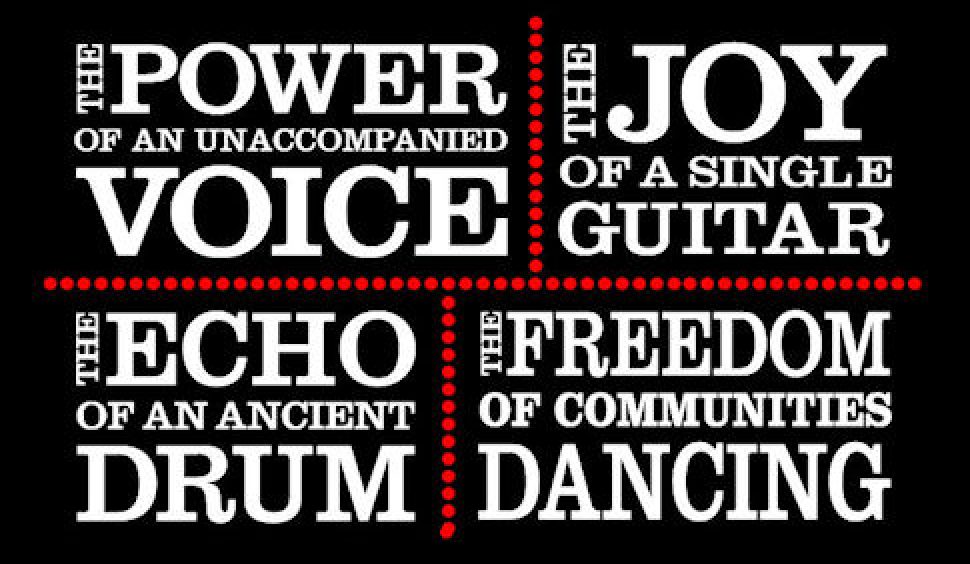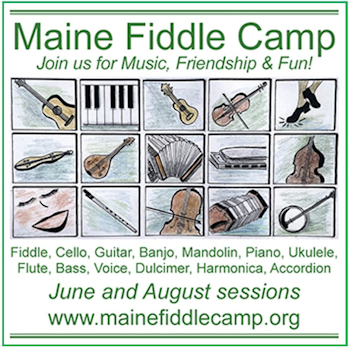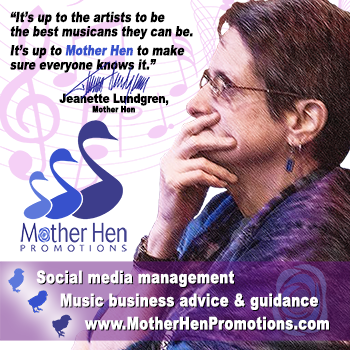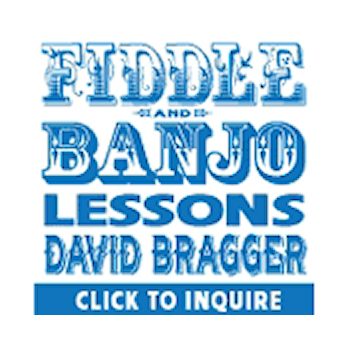SoCal Hawaiian Summer
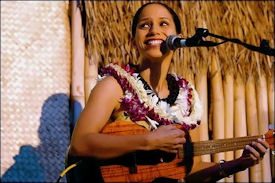
Redondo Beach
Performing Arts Center
July 18, 2009
Bathe your ears in the beautiful vocals of male and female falsetto singers gracing this second annual festival. The tradition of leo ki’eki’e is a style of singing in the upper registers above the singer’s normal vocal register to the accompaniment of ukulele and/or guitar. The break between the upper and lower vocal register, known as the ha’i, is an effect familiar to us the yodel sound.
Festival headliner Pomaika’i Keawe Lyman is the granddaughter of the late falsetto legend Genoa Keawe, known internationally for her sparkling interpretations and warm personality. Until her recent passing, Aunty Genoa entertained crowds with her extended ohana of musicians at the Marriott Waikiki Moana Terrace on Thursday evenings. I was lucky enough to see her show and experience her flute-like high notes floating on air. In her later years, Aunty Genoa lived in her son Eric’s house where granddaughter Pomaika’i absorbed not only the art of leo ki’eki’e but also the passion to pass on this Hawaiian cultural legacy. In fact, Pomaika’i now wears the musical mantle of her tutu at the Genoa Keawe Ohana show which continues weekly at the Marriott. The light, effortless quality of her high notes is reminiscent of Aunty Genoa and makes her an exciting choice for the Festival.
Male falsetto headliner Weldon Kekauoha has stayed on the radar of Hawaiian traditional music enthusiasts since he won the 2000 Na Hoku Hanohano Award (Hawaiian Grammy) for Most Promising Artist with his first solo album, Hawaiian Man. In 2008 he received the coveted Na Hoku award for Song of the Year.
It will be a treat to hear special guest Uncle Richard Ho’opi’i. Awarded the 1997 recipient of the National Endowment of the Arts Folk Heritage Fellowship, America’s highest honor for traditional artists, Uncle Richard has said, “When you sing Hawaiian music, you’re not just singing for yourself. You’re representing the kupuna who have guided and inspired you, and all the musicians that came before and will come after.”
A number of notable musicians will fill out the program. Vocalist and songwriter Leokani Pryor plays a regular gig at the Hotel Hana-Maui. Kekaimoku Yoshikawa, better known in the entertainment world simply as Moku, is a singer, songwriter, and kumu hula, leading hula halau in Torrance, California and in Japan. The house band includes Bryan Tolentino on ukulele and Alika-Boy Kalauli IV on bass guitar, both featured on CDs of Weldon Kekauoha, as well as slack-key/jazz guitarist Jeff Peterson, who played on the recent Grammy-winning slack key guitar compilations.
No festival can call itself Hawaiian without featuring hula, and as we shall see, SoCal boasts numerous hula halau. Members of Moku’s Kekaiulu Hula Studio will perform during the Falsetto Festival as will dancers from Halau Keali’i O Nalani and Halau Hula Na Meakanu O Laka O Hawai’i. The melding of music and hula is one of Hawaiian culture’s many gifts to the world.
Tickets for the 2pm and 7pm shows of the Southern California Aloha Falsetto Festival range from $25 to $75. For more information and to purchase tickets, visit AlohaFalsettoFest.com.
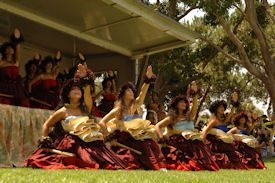
every year in Alondra Park. Photo: Lono Kollars
Ho’olaule’a
Alondra Park
Saturday, July 18
and
Sunday, July 19, 2009
Ho’olaule’a, which means Celebration, showcases the art of hula with performances by 13 halau from all corners of Southern California. Located in Alondra Park in the City of Lawndale, this free event has the laid-back atmosphere of a Hawaiian community fair. On the ample outdoor stage, Halau performances are scheduled hourly between 11am and 5pm on Saturday and between 11am and 4pm on Sunday. Note that the superbly disciplined, Los Angeles-based Halau Keali’i O Nalani under the direction of Keali’i Ceballos, is performing Sunday at 11am, a day after their stint in the Aloha Falsetto Festival. Note further that Halau O Lilinoe Na Pua Me Ke Aloha, the Carson-based halau (where yours truly takes hula classes) performs Saturday at noon. The choreography of kumu hula, Aunty Sissy Ka’io and Her daughter Annette Ka’io, is always unusual and thrilling to behold. (Hey, it’s true and it’s my column.)
Tip: If you want to claim your patch of grass for your blanket or chairs with a reasonable view of the outdoor stage, get there no later than 9:30am. You might even avoid the parking fee and find a meter on the street. A lot of Hawaiian families actually camp out in Alondra Park on Friday night in order to ensure they have a good spot. Also, bring sunscreen and a broad-brimmed hat.
The Hawaiian Inter-Club Council of Southern California, with over 30 member clubs, has hosted this event on the third weekend in July for the past 31 years. It is a gathering that attracts local Hawaiians and those of us who enjoy learning about the culture. “Hang loose as you sample Island-style food and browsing the crafts, jewelry, books, tropical plants and numerous information booths that open at 9am. www.hiccsc.org
Food to Enjoy
at Hawaiian Festivals and Between Festivals
The Falsetto Festival, Ho’olaule’a, and the event I will describe below “E Hula Mau” will feature food booths offering that down-home Hawaiian cooking that locals call ono– delicious. It is said that Hawaiians don’t eat until they are full. They eat until they are tired. And what do they like to eat? Scrambled eggs with piquant Portuguese sausage, lau-lau (meat – usually pork – combined with butterfish and steamed in taro leaves), lomi-lomi salmon (pieces of raw salmon combined with diced tomato and onion), poke (pieces of raw, fresh fish combined with seaweed and, traditionally, a kukui nut relish), poi (mashed, cooked taro root, an acquired taste), teriyaki beef and chicken, spam musubi (a kind of sushi roll that contains rice with spam instead of fish – ono-licious!) and sides of wonderfully rich macaroni salad and two scoops of hot, sticky rice. Open your mind, palate, and mouth to these wonderful flavors and textures.
Since the next special Hawaiian event doesn’t take place until August 29, let me suggest just a few places where you can find this kind of food and, in some cases, music to go along with it. Back Home in LaHaina, with restaurants in Torrance and Manhattan Beach prepares the above dishes and much more in super-generous portions. If you are calorie-conscious, go for the mouth-watering miso salmon with a side of sesame coleslaw. The Torrance restaurant features local halau performing Hawaiian music and hula most Friday evenings. The Loft and King’s Hawaiian, also in Torrance, have similar menus and will leave you fatter and happier. No music at the latter two, to my knowledge. Bob’s Ohana Hawaiian Style Restaurant in Gardena is legendary for its family atmosphere and generous Da Kine-style grinds. Famous: the “Go for Broke” plate –pork or chicken katsu (breaded), fried chow fun-style noodles, mac salad and two pieces of their delicious nori chicken (cooked chicken sushi would be the shortest explanation). The hours are Sun.-Wed. 6:30am-3pm and Thurs., Fri., Sat. 6:30am-8pm. Last time I checked, Bob’s featured live Hawaiian music on Thursday nights as well as on the weekends. Bruddah’s Hawaiian Foods, also in Gardena, gets a great review from Aloha Falsetto Festival organizer Mitch Chang, who is having Bruddah’s do food for the Aloha Falsetto Festival. The above eateries should get you through to the next event.
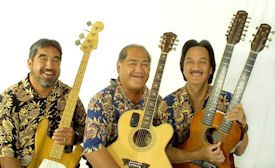
Aloha Series
Season Opener
Whittier College
August 29, 2009
3pm and 8pm
The longest running Hawaiian concert series in the country starts its 16th season with a powerful musical combo — George Kuo on six and 12 string slack key guitar, Aaron Mahi on bass guitar, Martin Pahinui on 6 string slack key guitar, and Bobby Ingano on Hawaiian steel guitarist. These well-known musicians play with flawless technique and deep respect for the Hawaiian traditional music. Furthermore, Martin Pahinui has the sweetest falsetto voice to be heard since his father, Gabby Pahinui brought slack key guitar and his soulful falsetto to the forefront of the Hawaiian scene some 40 years ago.
The Ruth B. Shannon Center for the Performing Arts is the venue of choice for many top Hawaiian musicians visiting the mainland because of the lovely theatre setting and the tender treatment and spirit of aloha they receive. Theater manager David Palmer introduces each concert with help from webcaster Aloha Joe and other regulars and guests, creating a community of the Hawaiian at heart. To purchase tickets and learn about the four other Aloha Series concerts, go to www.shannoncenter.org or call 562-907-4203.
For yours truly, August 29 will be a Hawaiian cultural and L.A. freeway experience. After taking in the 3 pm Aloha Series concert in Whittier, we will zoom over to the Ford Amphitheatre for the 8:30 pm performance of Na Ali’i: The Hawaiian Monarchs, the next event to peruse.
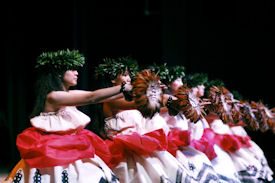 Na Ali’i:
Na Ali’i:
The Hawaiian Monarchs
Ford Amphitheatre
August 29, 2009
8:30pm.
Na Ali’i tells the story of the Hawaiian monarchy through traditional dance and music.
This performance marks the local debut of the Kilohana Dance Company, under the direction of Rolanda Reese. Na Ali’i pays tribute to the Hawaiian monarchy, starting with the unifier of the Islands, Kamehameha and ending with Queen Liliokalani, who was deposed by Americans in 1893. It is a rare opportunity to learn about the history and cultural roots of Hawai’i through what King David Kalakaua called hula “the heartbeat of the Hawaiian people. The dances begin with the ancient hula kahiko that accompanied chant to the beat of the gourd drum. As the story unfolds, the dance will move on to the auana, modern hula which, in Reese’s eloquent words, “exudes grace and a flowing essence that melts the heart.” In addition to the traditional gourd drum, the musical element of the performance will include three members of the celebrated vocal quartet Ho’okena and a choir of local Pacific Islanders from the choir of the First Samoan Congregational Church of Harbor City. The story of the Hawaiian monarchs will be narrated by Bay Area kumu hula Patrick Makuakane, whose halau was featured in the PBS documentary, Hula Beyond Hawai’i.
Most intriguing is the use of traditional chant to demonstrate the actual evolution of chanting. Artistic director Rolanda Reese has won awards for chant and dance in the E Hula Mau Competition (to be discussed below), teaches dance at Loyola Marymount University, and has been presenting Hawaiian cultural workshops through the Ke Po’okela Cultural Foundation (KPCF) for over 20 years. Co-sponsored by the Ford and the KPCF, Na Ali’i: the Hawaiian Monarchs promises to be a breathtaking show.
Tickets purchased by August 22 are $30. To order tickets and get more information, consult fordamphitheater.org or call the box office at 323-461-3673.
E Hula Mau
Competition and Festival
Long Beach Terrace Theatre
Sept. 4-5-6, 2009
While others clog the beaches and freeways for Labor Day weekend, yours truly head to the Terrace Theater of the Long Beach Convention Center for E Hula Mau.. The name E Hula Mau was bestowed by the late Nona Beamer, revered hula teacher, storyteller, and Hawaiiana educator, and means Hula Lives! From Friday afternoon till Sunday evening 14 halau from California, Nevada, and Washington State will compete in the categories of solo performances, hula kahiko (ancient-style hula) and hula auana (contemporary hula).
Apart from the competition, the festival also features a Hawaiian Village where musical instruments and crafts such as lei-making are demonstrated. You can participate, as I have in years past, and make your own lei. It was at E Hula Mau that I first learned to play the Hawaiian nose flute. (It has a gentle, airy sound and I often begin my day by playing it for a few minutes.)
Both inside the theater and outside on the mall, booths galore surround you with Hawai’i-inspired jewelry, clothing, crafts, Hawaiiana publications, and too many knickknacks to name. Buy tickets for the plate lunches outside and enjoy many of the dishes mentioned above for under $10. Spend time outside listening to various bands play outside on the mall, where the spray of the fountains counteracts the heat of the day. In fact, you can visit the outdoor booths, plate lunches, and enjoy the music without even buying tickets for E Hula Mau!
But I wouldn’t miss the intensity of the competition where eminent kumu hula from Hawai’i scrutinize performances by each halau for their movements, their demeanor, their costumes, their use of the Hawaiian language (in the kahiko competition), and other criteria. Master of Ceremonies Frank Kawaikapuokalani Hewett, beloved kumu, dancer, and songwriter, will introduce the contestants and keep the show moving for two and a half days with his blend of knowledge and humor. When he spontaneously rises from his chair and dances, his grace and precision of movement just about make you melt in your seat.
Trophies are awarded after each category of the competition and special recognition awards come at the end. Often running neck-in-neck for awards are Hula Halau Nalani, lauded above, and the halau to which I belong, Hula Halau O Lilinoe (No, I am not dancing. I am far, far, far from being material for the Halau O Lilinoe competition class!)
A detailed schedule for E Hula Mau is available at namamo.org.
Saturday evening gives everyone a break from hula with a concert known as the Mahalo Bash. This year the choice of entertainers could not be better. The trio Maunalua plays traditional and contemporary Hawaiian music with warmth and flair. Bobby Moderow is a master slack key guitar player and, sings a gorgeous falsetto along with trio member Kahi Kaonohi. I will share a personal experience with you – indulge me, please: When I chatted with Bobby in Honolulu two years ago, I shared that I was a hula student. He actually convinced me to get up and dance to the song of my choice at the Marriott Moana Terrace the following week. When the moment came, at first I felt terrified, but Maunalua’s lovely interpretation of “Pua Hone” (Honey Flower) inspired me to dance from the heart and I ended up doing an encore “I Fell in Love with Honolulu. It was one of the most joyous dance experiences of my life.
It is possible to buy separate tickets for one or more of the days of E Hula Mau plus the Mahalo Bash. You can buy tickets through tickets@namamo.org.
These are the major events I know that will help create your own Hawaiian Summer in Southern California. For information on other performances “and they pop up all the time get on the mailing list for Kala Koa Entertainment, which you can join through the link on alohafalsettofest.com.
Finally, I have a confession to make: My personal Hawaiian Summer will include a trip to O’ahu. I will be attending Ka’Aha Hula July 25-31, the international conference where the cream of the hula world will lead hula students in dance, study, and field trips to places of historical and mythological importance for Hawaiians. We’re taking a few extra days to nip over to some of the hotels at Waikiki at night to hear wonderful musicians – maybe some of the people named above.
Luckily, my Hawai’i trip won’t interfere with attending any of the events of our Southern California Hawaiian Summer.
Audrey Coleman-Macheret is a writer, educator, and passionate explorer of traditional folk music and world cultures.

